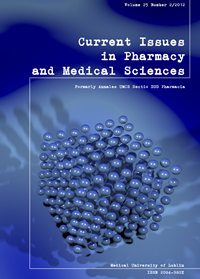Determination of oleanolic and ursolic acid in bilberries (Vaccinium myrtillus L.)
DOI:
https://doi.org/10.12923/j.2084-980X/25.2/a.07Keywords:
Vaccinium myrtillus, oleanolic acid, ursolic acid, HPTLC with densitometryAbstract
Vaccinium myrtillus (Ericaceae) is used in therapy of various illnesses. Oleanolic and ursolic acids are bioactive triterpenes, which can influence the biological activity of this plant. High-performance thin layer chromatography combined with densitometry was used to determine the content of these compounds in ethanolic extracts from the leaves and fruits of Vaccinum myrtillus L. The samples of extracts were treated of 1% iodine solution in chloroform and next separated on HPTLC Si 60 F254 plates using mixture of toluene-petroleum ether-diethyl ether 15:15:10 (v/v) as a mobile phase. After drying, the plates were sprayed with 10% (v/v) H2SO4 in ethanol and heated for 2-3 minutes at the temperature of 120°C. The quantification was carried out by densitometric scanning in flurescence/reflectance mode at λ = 400 nm. The determined contents of oleanolic and ursolic acid were 0.18 mg/g and 0.33 mg/g of dry herb in fruits and 1.16 mg/g and 0.28 mg/g in leaves of Vaccinium myrtillus, respectively.
References
1. Anonymous: Monograph. Vaccinium myrtillus (bilberry). Altern. Med. Rev., 6, 500, 2001.
2. Baj A et al.: Qualitative and quantitative evaluation of Vaccinium myrtillus anthocyanins by high-resolution gas chromatography and high-performance liquid chromatography. J. Chromatography, 279, 365, 1983.
3. Canter PH, Ernst E: Anthocyanosides of Vacinnium myrtillus (bilberry) for night visions a systematic review of placebo controlled trials. Surv. Ophthalmol., 49, 38, 2004.
4. Garzón GA et al.: Chemical composition, anthocyanins, non-anthocyanin phenolics and antioxidant activity of wild bilberry (Vaccinium meridionale Swartz) from Colombia. Food Chem., 122, 980, 2010.
5. Liu J: Pharmacology of oleanolic acid and ursolic acid. J. Ethnopharmacol., 49, 57, 1995.
6. Liu J: Oleanolic acid and ursolic acid: research perspectives. J. Ethnopharmacol., 100, 92, 2005.
7. Madhavi DL et al.: Isolation of bioactive conctituents from Vaccinium myrtillus (bilberry) fruits and cell cultures. Plant Sci., 131, 95, 1998.
8. Noculak-Palczewska A: Porównanie wartości terapeutycznej preparatów z owoców borówki. Post. Fitoter., 1, 10, 2004.
9. Valentová K et al.: Cytoprotective effect of a bilberry extract against oxidative damage of rat hepatocytes. Food Chem., 101, 912, 2007.
10. Wójciak-Kosior M: Separation and determination of closely related triterpenic acids by high performance thin-layer chromatography after iodine derivatization. J. Pharm. Biomed. Anal., 45, 337, 2007.
Downloads
Published
Issue
Section
License
Copyright (c) 2012 Authors

This work is licensed under a Creative Commons Attribution-NonCommercial-NoDerivatives 3.0 Unported License.


